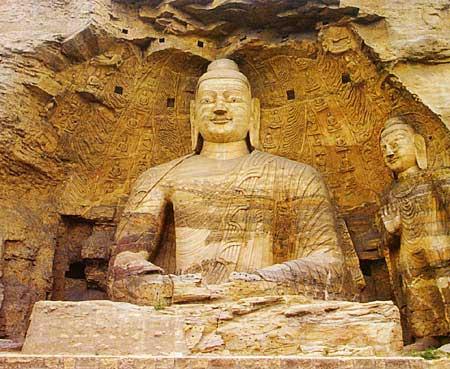
 |
| Yungang Grottoes (CNTV) |
Watch Video: The Yungang Grottoes - Bridging weight and Grace
Date of Inscription: 2001
Assessment of the World Heritage Committee
Locating in Datong City, Shanxi Province, the Yungang Grottoes has 252 shrines and over 51,000 statues, representing outstanding Buddhist grotto art in China between the 5th century AD and 6th century AD. Among these caves, the "Tan Yao Five Caves" has a strict and unified layout and is the classic masterpiece in the first noontide of the Chinese Buddhist art.
Chinese name: Yun Gang Shi Ku
English name: Yungang Grottoes
According to cultural and natural heritage selection criteria C(I)(II)(III)(IV), the Yungang Grottoes was included in the World Heritage List in December 2001.
The Yungang Grottoes is located in the foot of the Wuzhou Mountain in the south, 16 kilometers west of Datong City in Shanxi Province in northern China. It is home to a large number of Buddhist sculptures. The Yungang Grottoes was dug for the first time in the Second Xing'an Year of the Northern Wei Dynasty in 453 AD under Tan Yao's direction, who was a Buddhist eminent monk at the time. It was basically completed before the Northern Wei Dynasty moved its capital to Luoyang in 494 AD while the statues engraving project had been continued to the Zhengguang Year period between 520 AD and 525 AD. The grotto was dug at the hillside and is about one kilometer from east to west. There are 45 major caves, 252 shrines and over 51,000 stone statues, broken or unbroken, with the largest standing 17 meters tall and the smallest only a few centimeters tall. The Yungang Grottoes plus the Mogao Grottoes in Dunhuang and the Longmen Grottoes in Henan are known as "three major stone grottoes in China" and also one of the world-famous stone carving art collections. The statues in the Yungang Grottoes are imposing and rich in content and can be called the best among Chinese stone carvings in the 5th century AD.

















 Rainstorms flood more than 10,000 cars in underground garages in Wuhan
Rainstorms flood more than 10,000 cars in underground garages in Wuhan


![]()
